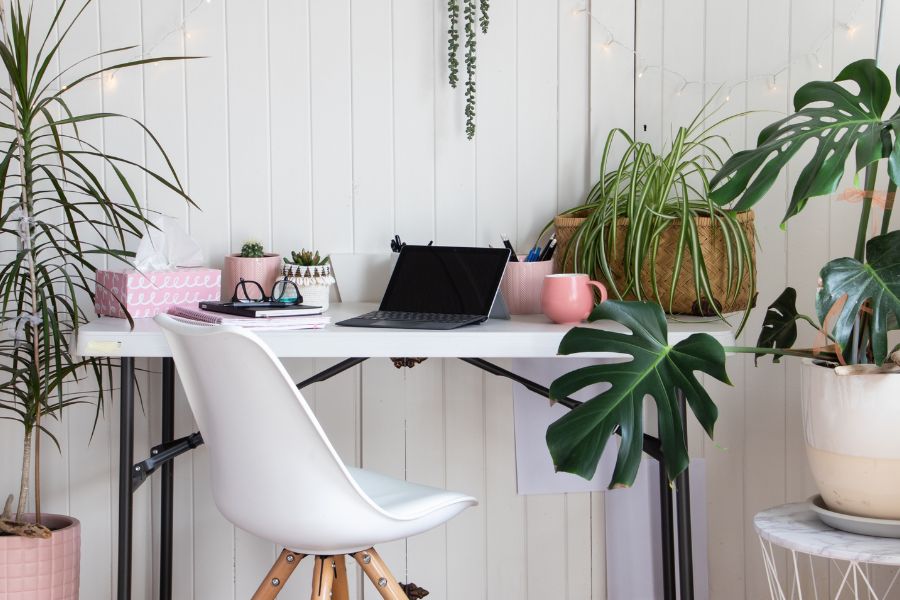The design of your home office can significantly impact your mood, creativity, and overall productivity. Two popular design approaches are a plant-filled office and a minimalist office, each offering unique benefits and challenges.
A plant-filled office brings nature indoors, creating a vibrant and calming environment, while a minimalist office focuses on simplicity and functionality, reducing distractions and clutter.
This article explores the dynamics of remote work in a plant-filled office versus a minimalist office, examining which setup is more inspiring and how to optimize your workspace for maximum creativity and efficiency.
By the end, you’ll have a clearer understanding of how to design a workspace that inspires and supports your remote work experience.
1. The Importance of Office Design in Remote Work
Office design plays a crucial role in creating a productive and inspiring work environment. The layout, decor, and overall ambiance of your workspace can influence your mood, focus, and creativity.
For remote workers, who often spend long hours in their home offices, the design of the workspace is especially important.
Understanding the pros and cons of a plant-filled office and a minimalist office can help you make an informed decision and create a workspace that enhances your productivity and well-being.
2. Remote Work with a Plant-Filled Office

A plant-filled office incorporates various plants and greenery into the workspace, creating a natural and vibrant environment.
Let’s explore the advantages and disadvantages of working in a plant-filled office.
2.1 Advantages of a Plant-Filled Office
a) Improved Air Quality
Plants can improve air quality by filtering out toxins and increasing oxygen levels.
- Air Purification: Certain plants, such as spider plants and peace lilies, are known for their air-purifying properties.
- Oxygen Boost: Plants release oxygen, which can enhance your overall well-being and cognitive function.
b) Enhanced Mood and Creativity
A plant-filled office can boost your mood and creativity by creating a calming and inspiring environment.
- Stress Reduction: The presence of plants can reduce stress and promote relaxation, improving your mental health.
- Creative Inspiration: A natural environment can stimulate creativity and provide a sense of inspiration.
c) Aesthetic Appeal
Plants add aesthetic appeal to your workspace, making it more visually pleasing and enjoyable.
- Visual Interest: Plants can add color, texture, and life to your office, creating a more dynamic and engaging environment.
- Personalization: Incorporating plants allows you to personalize your workspace and reflect your personality.
d) Noise Reduction
Plants can help reduce noise levels by absorbing sound, creating a quieter and more focused workspace.
- Sound Absorption: Plants can absorb and diffuse sound, reducing background noise and distractions.
- Quiet Environment: A quieter workspace can enhance focus and productivity.
e) Connection to Nature
A plant-filled office provides a connection to nature, which can improve your overall well-being.
- Biophilic Design: Incorporating natural elements into your workspace aligns with biophilic design principles, which emphasize the human connection to nature.
- Mental Health Benefits: A connection to nature can reduce anxiety, improve mood, and enhance overall mental health.
2.2 Disadvantages of a Plant-Filled Office
a) Maintenance Requirements
Plants require regular maintenance, which can be time-consuming and challenging.
- Watering and Care: You need to water, prune, and care for your plants to keep them healthy.
- Pest Control: Plants can attract pests, requiring additional effort to manage.
b) Space Constraints
Incorporating plants into your office can take up valuable space, especially in smaller workspaces.
- Limited Space: Plants can occupy desk space, floor space, or shelving, potentially reducing available workspace.
- Clutter: Too many plants can create a cluttered environment, which may be distracting.
c) Allergies and Sensitivities
Some people may have allergies or sensitivities to certain plants, which can affect their comfort and health.
- Allergic Reactions: Pollen or plant allergens can cause allergic reactions, such as sneezing or itching.
- Sensitivities: Some individuals may be sensitive to the smell or texture of certain plants.
d) Cost
Purchasing and maintaining plants can involve additional costs.
- Initial Investment: Buying plants, pots, and soil can be an initial expense.
- Ongoing Costs: Regular maintenance, such as fertilizers and pest control, can add to the cost.
3. Remote Work with a Minimalist Office

A minimalist office focuses on simplicity and functionality, reducing clutter and distractions to create a clean and organized workspace.
Let’s explore the advantages and disadvantages of working in a minimalist office.
3.1 Advantages of a Minimalist Office
a) Reduced Distractions
A minimalist office reduces clutter and distractions, allowing you to focus more effectively.
- Clear Space: A clean and organized workspace can enhance focus and reduce mental clutter.
- Fewer Distractions: With fewer items in your office, there are fewer distractions to pull your attention away from work.
b) Improved Productivity
A minimalist office can improve productivity by creating a streamlined and efficient work environment.
- Efficient Workflow: A clutter-free workspace allows for a more efficient workflow, reducing the time spent searching for items.
- Focus on Tasks: A minimalist environment helps you concentrate on tasks without unnecessary interruptions.
c) Aesthetic Simplicity
A minimalist office offers aesthetic simplicity, creating a calm and serene environment.
- Clean Lines: Minimalist design emphasizes clean lines and simplicity, creating a visually pleasing and calming space.
- Neutral Colors: Neutral color palettes can create a soothing and focused atmosphere.
d) Ease of Maintenance
A minimalist office is easier to maintain and keep organized.
- Less Cleaning: With fewer items, cleaning and organizing your workspace is quicker and easier.
- Simplified Routine: A minimalist approach reduces the need for constant tidying and maintenance.
e) Cost-Effective
A minimalist office can be more cost-effective, as it requires fewer items and decorations.
- Lower Initial Cost: You don’t need to invest in a lot of furniture or decor, reducing initial expenses.
- Reduced Ongoing Costs: With fewer items to maintain or replace, ongoing costs are minimized.
3.2 Disadvantages of a Minimalist Office
a) Lack of Personalization
A minimalist office may lack personalization, making it feel less inviting and inspiring.
- Impersonal Environment: A lack of personal touches can make the workspace feel sterile or impersonal.
- Limited Expression: Minimalism may limit your ability to express your personality and creativity through decor.
b) Potential for Monotony
A minimalist office can sometimes feel monotonous or uninspiring.
- Lack of Visual Interest: The absence of decor and color can make the workspace feel dull or unstimulating.
- Reduced Creativity: A lack of visual stimulation may reduce creativity and inspiration.
c) Functional Limitations
A minimalist office may lack certain functional elements that enhance comfort and productivity.
- Limited Storage: Minimalist design often emphasizes open space, which may limit storage options.
- Comfort Sacrifices: In pursuit of simplicity, you may sacrifice comfort, such as ergonomic furniture or cozy decor.
d) Initial Setup Effort
Creating a minimalist office requires careful planning and effort to declutter and organize.
- Decluttering Process: Transitioning to a minimalist office can involve a significant decluttering process.
- Design Planning: You need to carefully plan the layout and design to achieve a minimalist aesthetic.
4. Comparing Plant-Filled Office and Minimalist Office
To determine which office design is more inspiring, it’s important to consider the specific dynamics of each approach.
4.1 When a Plant-Filled Office Excels
- Mood and Creativity
A plant-filled office can boost mood and creativity by creating a calming and inspiring environment. - Aesthetic Appeal
Plants add aesthetic appeal and visual interest, making the workspace more enjoyable. - Connection to Nature
A plant-filled office provides a connection to nature, enhancing overall well-being.
4.2 When a Minimalist Office Excels
- Focus and Productivity
A minimalist office reduces distractions and enhances focus, improving productivity. - Aesthetic Simplicity
Minimalist design offers aesthetic simplicity, creating a calm and serene environment. - Ease of Maintenance
A minimalist office is easier to maintain and keep organized.
5. Key Factors to Consider
When deciding between a plant-filled office and a minimalist office, consider the following factors to determine which setup is more inspiring for your remote work needs.
5.1 Personal Preferences
Evaluate your personal preferences and how they align with each office design.
- Nature Lovers: If you enjoy nature and find it inspiring, a plant-filled office may be more appealing.
- Simplicity Seekers: If you prefer simplicity and a clutter-free environment, a minimalist office may be better.
5.2 Work Requirements
Consider the nature of your work and how it aligns with each office design.
- Creative Work: If your work requires creativity and inspiration, a plant-filled office may be more suitable.
- Focused Work: If your work requires deep focus and minimal distractions, a minimalist office may be more effective.
5.3 Space Availability
Think about the space available in your home office and how it accommodates each design.
- Spacious Office: If you have ample space, a plant-filled office may be feasible.
- Small Office: If space is limited, a minimalist office may be more practical.
5.4 Maintenance and Cost
Assess your willingness to maintain plants and the costs associated with each design.
- Maintenance Willingness: If you’re willing to invest time in plant care, a plant-filled office may be worth it.
- Budget-Conscious: If you prefer a low-maintenance and cost-effective setup, a minimalist office may be better.
6. Key Takeaways and Recommendations
Deciding between a plant-filled office and a minimalist office depends on your specific needs, preferences, and work requirements.
Here are some key takeaways and recommendations to help you choose.
- Choose a Plant-Filled Office If: You value mood enhancement, creativity, and a connection to nature, and you’re willing to invest in plant care.
- Choose a Minimalist Office If: You prefer focus, productivity, and aesthetic simplicity, and you want a low-maintenance workspace.
- Hybrid Approach: Consider a hybrid approach by incorporating a few plants into a minimalist office. This can offer a balance of inspiration and simplicity.
Conclusion
The choice between remote work in a plant-filled office or a minimalist office ultimately depends on your personal preferences, work requirements, and available space.
A plant-filled office offers mood enhancement, creativity, and a connection to nature, making it ideal for those who find inspiration in natural elements. A minimalist office provides focus, productivity, and aesthetic simplicity, making it suitable for those who prefer a clutter-free and streamlined environment.
By carefully evaluating your priorities and experimenting with both designs, you can create a workspace that inspires and supports your remote work experience.
Whether you choose a plant-filled office, a minimalist office, or a hybrid approach, the key is to design a workspace that meets your needs and fosters creativity, productivity, and well-being.
